Diploma in Early Childhood Education and Care Leadership Assignment
VerifiedAdded on 2022/10/09
|12
|2677
|13
Homework Assignment
AI Summary
This assignment, completed for a Diploma in Early Childhood Education and Care, focuses on leadership within the Wintergrove Education and Care Service. The assignment is divided into three parts. Part 1 centers on contributing to and promoting effective work practices and workplace relations, including the service's philosophy, communication structures, and staffing requirements, including qualifications and rosters. Part 2 addresses developing and implementing staffing processes, including recruitment strategies, interview processes, and educator responsibilities. Part 3 covers performance review processes for newly recruited educators, setting work goals, and promoting effective workplace relations through training and coaching models like the GROW model. The assignment requires the student to act as the Nominated Supervisor, making decisions and implementing strategies to improve the service's operations and educator performance.
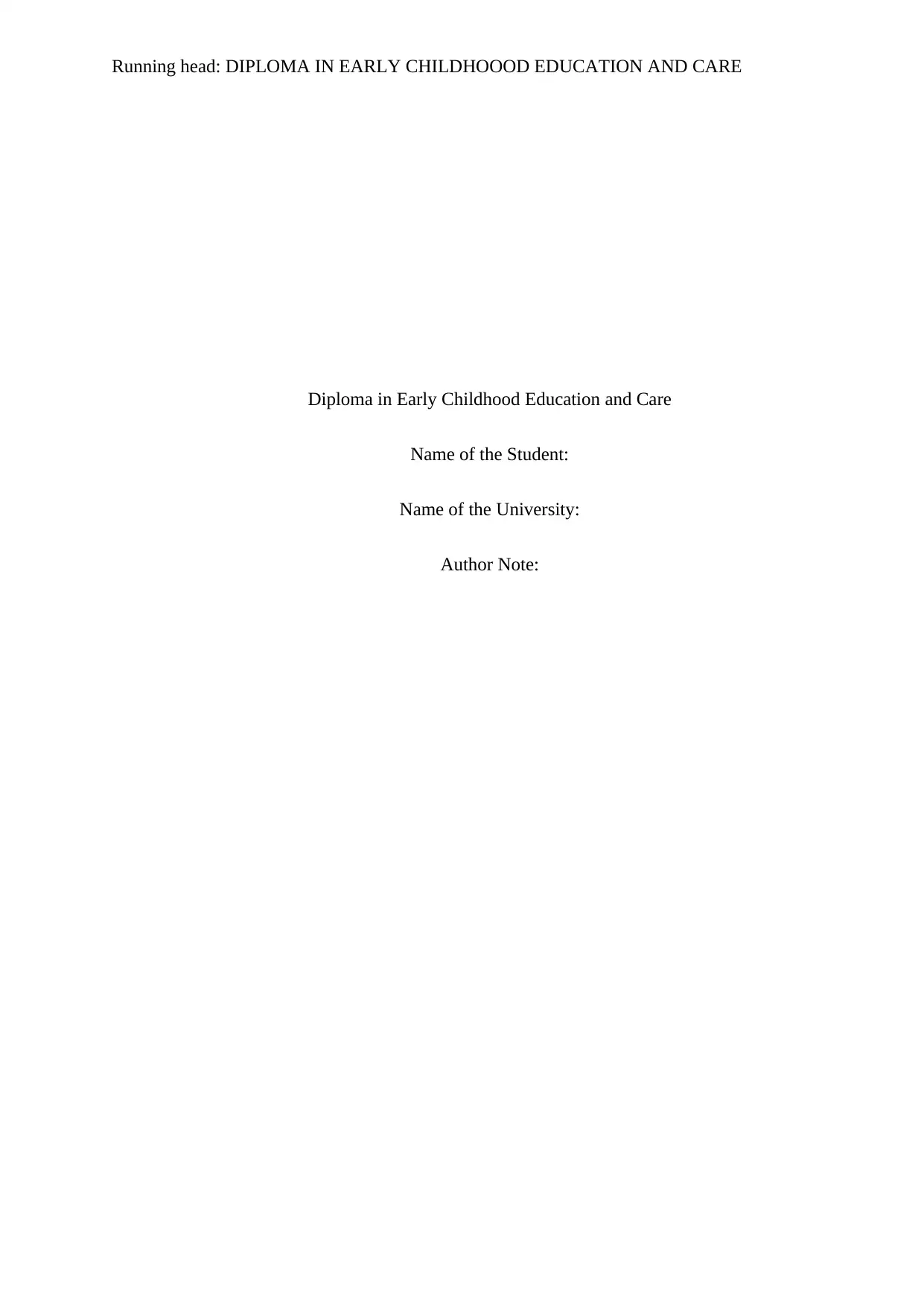
Running head: DIPLOMA IN EARLY CHILDHOOOD EDUCATION AND CARE
Diploma in Early Childhood Education and Care
Name of the Student:
Name of the University:
Author Note:
Diploma in Early Childhood Education and Care
Name of the Student:
Name of the University:
Author Note:
Paraphrase This Document
Need a fresh take? Get an instant paraphrase of this document with our AI Paraphraser
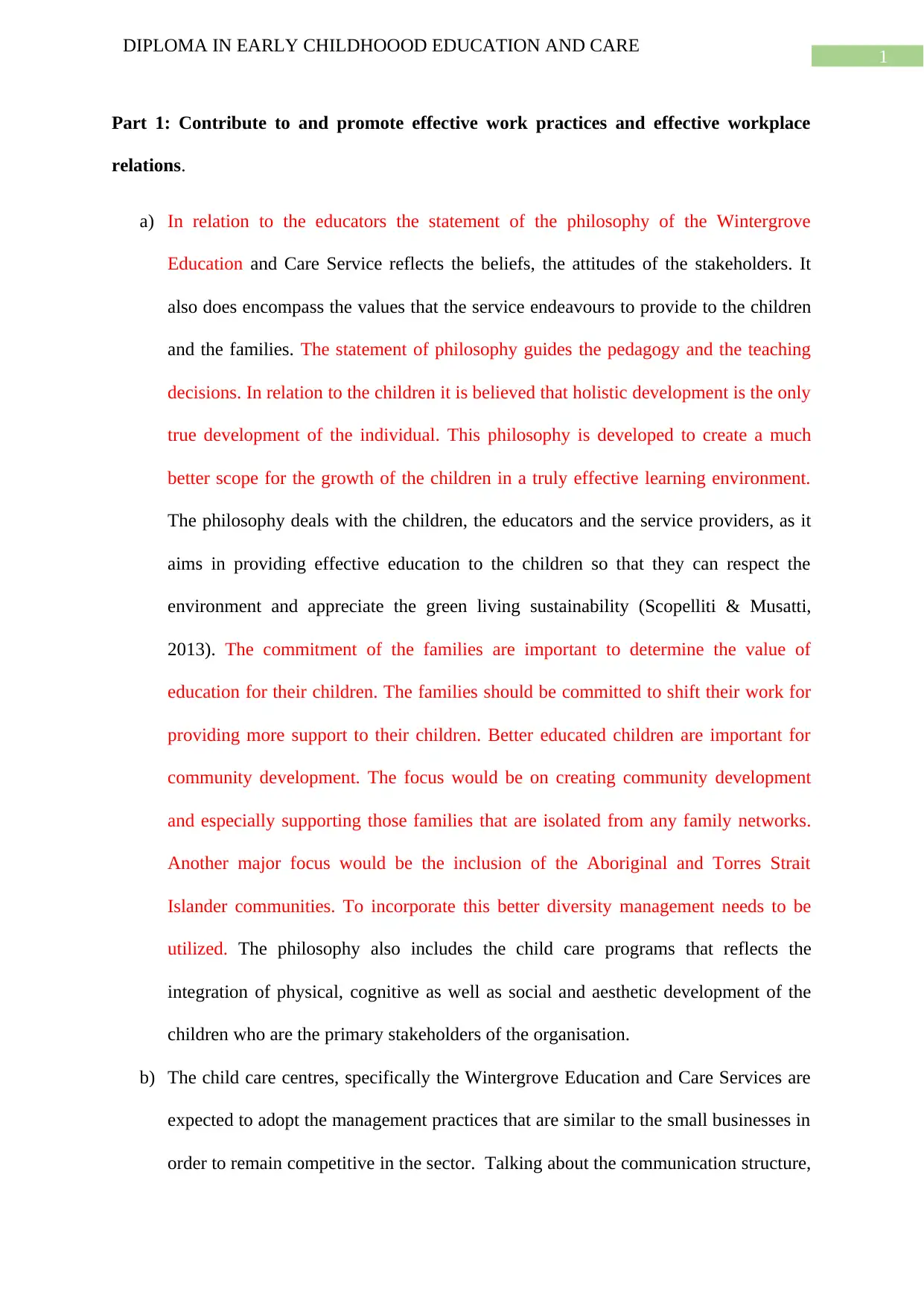
1
DIPLOMA IN EARLY CHILDHOOOD EDUCATION AND CARE
Part 1: Contribute to and promote effective work practices and effective workplace
relations.
a) In relation to the educators the statement of the philosophy of the Wintergrove
Education and Care Service reflects the beliefs, the attitudes of the stakeholders. It
also does encompass the values that the service endeavours to provide to the children
and the families. The statement of philosophy guides the pedagogy and the teaching
decisions. In relation to the children it is believed that holistic development is the only
true development of the individual. This philosophy is developed to create a much
better scope for the growth of the children in a truly effective learning environment.
The philosophy deals with the children, the educators and the service providers, as it
aims in providing effective education to the children so that they can respect the
environment and appreciate the green living sustainability (Scopelliti & Musatti,
2013). The commitment of the families are important to determine the value of
education for their children. The families should be committed to shift their work for
providing more support to their children. Better educated children are important for
community development. The focus would be on creating community development
and especially supporting those families that are isolated from any family networks.
Another major focus would be the inclusion of the Aboriginal and Torres Strait
Islander communities. To incorporate this better diversity management needs to be
utilized. The philosophy also includes the child care programs that reflects the
integration of physical, cognitive as well as social and aesthetic development of the
children who are the primary stakeholders of the organisation.
b) The child care centres, specifically the Wintergrove Education and Care Services are
expected to adopt the management practices that are similar to the small businesses in
order to remain competitive in the sector. Talking about the communication structure,
DIPLOMA IN EARLY CHILDHOOOD EDUCATION AND CARE
Part 1: Contribute to and promote effective work practices and effective workplace
relations.
a) In relation to the educators the statement of the philosophy of the Wintergrove
Education and Care Service reflects the beliefs, the attitudes of the stakeholders. It
also does encompass the values that the service endeavours to provide to the children
and the families. The statement of philosophy guides the pedagogy and the teaching
decisions. In relation to the children it is believed that holistic development is the only
true development of the individual. This philosophy is developed to create a much
better scope for the growth of the children in a truly effective learning environment.
The philosophy deals with the children, the educators and the service providers, as it
aims in providing effective education to the children so that they can respect the
environment and appreciate the green living sustainability (Scopelliti & Musatti,
2013). The commitment of the families are important to determine the value of
education for their children. The families should be committed to shift their work for
providing more support to their children. Better educated children are important for
community development. The focus would be on creating community development
and especially supporting those families that are isolated from any family networks.
Another major focus would be the inclusion of the Aboriginal and Torres Strait
Islander communities. To incorporate this better diversity management needs to be
utilized. The philosophy also includes the child care programs that reflects the
integration of physical, cognitive as well as social and aesthetic development of the
children who are the primary stakeholders of the organisation.
b) The child care centres, specifically the Wintergrove Education and Care Services are
expected to adopt the management practices that are similar to the small businesses in
order to remain competitive in the sector. Talking about the communication structure,
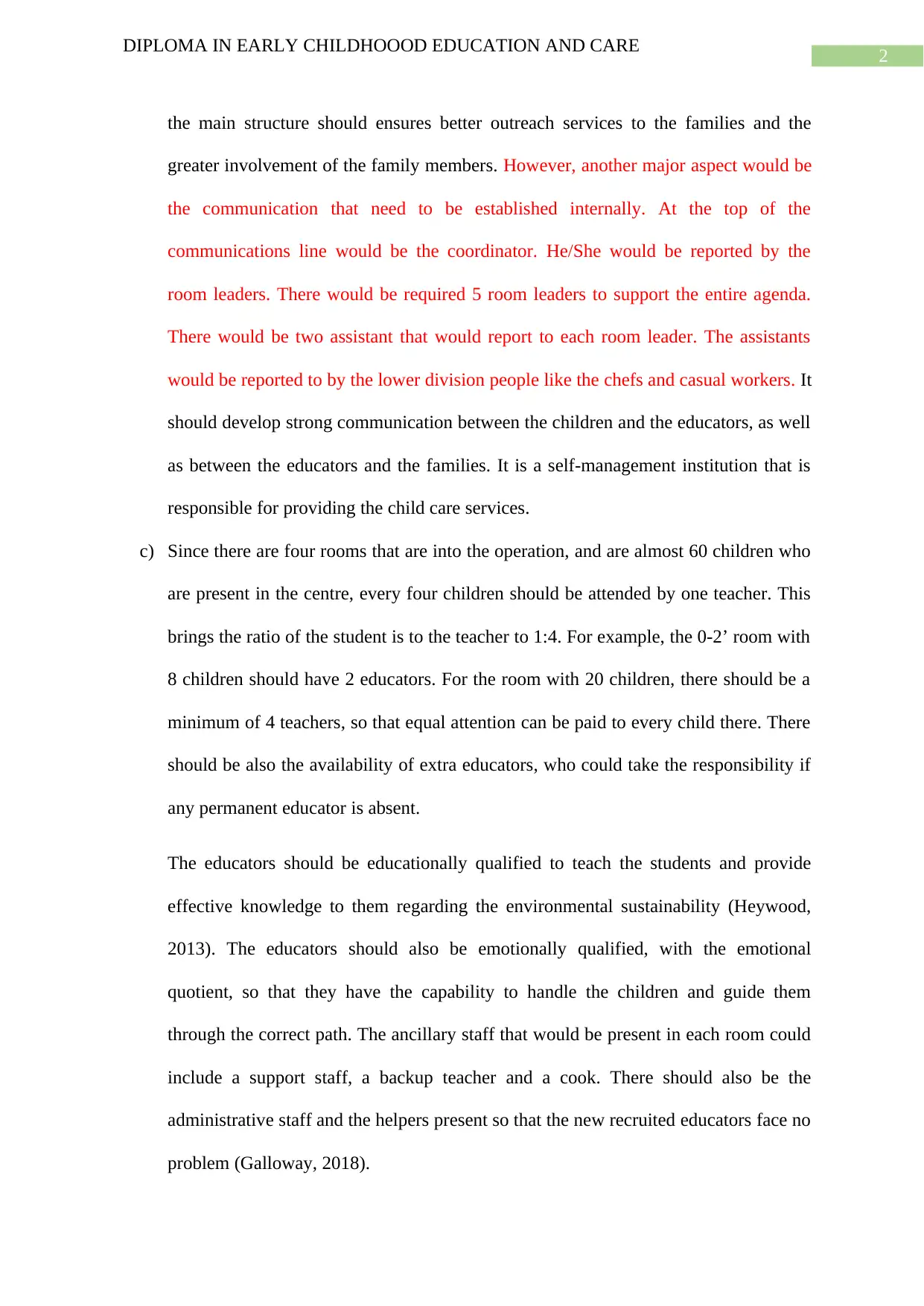
2
DIPLOMA IN EARLY CHILDHOOOD EDUCATION AND CARE
the main structure should ensures better outreach services to the families and the
greater involvement of the family members. However, another major aspect would be
the communication that need to be established internally. At the top of the
communications line would be the coordinator. He/She would be reported by the
room leaders. There would be required 5 room leaders to support the entire agenda.
There would be two assistant that would report to each room leader. The assistants
would be reported to by the lower division people like the chefs and casual workers. It
should develop strong communication between the children and the educators, as well
as between the educators and the families. It is a self-management institution that is
responsible for providing the child care services.
c) Since there are four rooms that are into the operation, and are almost 60 children who
are present in the centre, every four children should be attended by one teacher. This
brings the ratio of the student is to the teacher to 1:4. For example, the 0-2’ room with
8 children should have 2 educators. For the room with 20 children, there should be a
minimum of 4 teachers, so that equal attention can be paid to every child there. There
should be also the availability of extra educators, who could take the responsibility if
any permanent educator is absent.
The educators should be educationally qualified to teach the students and provide
effective knowledge to them regarding the environmental sustainability (Heywood,
2013). The educators should also be emotionally qualified, with the emotional
quotient, so that they have the capability to handle the children and guide them
through the correct path. The ancillary staff that would be present in each room could
include a support staff, a backup teacher and a cook. There should also be the
administrative staff and the helpers present so that the new recruited educators face no
problem (Galloway, 2018).
DIPLOMA IN EARLY CHILDHOOOD EDUCATION AND CARE
the main structure should ensures better outreach services to the families and the
greater involvement of the family members. However, another major aspect would be
the communication that need to be established internally. At the top of the
communications line would be the coordinator. He/She would be reported by the
room leaders. There would be required 5 room leaders to support the entire agenda.
There would be two assistant that would report to each room leader. The assistants
would be reported to by the lower division people like the chefs and casual workers. It
should develop strong communication between the children and the educators, as well
as between the educators and the families. It is a self-management institution that is
responsible for providing the child care services.
c) Since there are four rooms that are into the operation, and are almost 60 children who
are present in the centre, every four children should be attended by one teacher. This
brings the ratio of the student is to the teacher to 1:4. For example, the 0-2’ room with
8 children should have 2 educators. For the room with 20 children, there should be a
minimum of 4 teachers, so that equal attention can be paid to every child there. There
should be also the availability of extra educators, who could take the responsibility if
any permanent educator is absent.
The educators should be educationally qualified to teach the students and provide
effective knowledge to them regarding the environmental sustainability (Heywood,
2013). The educators should also be emotionally qualified, with the emotional
quotient, so that they have the capability to handle the children and guide them
through the correct path. The ancillary staff that would be present in each room could
include a support staff, a backup teacher and a cook. There should also be the
administrative staff and the helpers present so that the new recruited educators face no
problem (Galloway, 2018).
⊘ This is a preview!⊘
Do you want full access?
Subscribe today to unlock all pages.

Trusted by 1+ million students worldwide

3
DIPLOMA IN EARLY CHILDHOOOD EDUCATION AND CARE
The qualifications for each educators would be minimum graduate. There is a
need for 2-3 educators that are either qualified with teacher diploma or cert 3 qualified
staffs.
0-2 Room 1- 8 children- 2 educators
Educator 1- (Cert. 3)
Educator 2- (graduate)
0-2 Room 2- 12 Children- 3 educators
Educator 1- Cert. 3
Educator 2- Graduate
Educator 3- Graduate
0-2 Room 3- 20 children- 4 educators
Educator 1- Cert. 3
Educator 2- Cert. 3
Educator 3- Graduate
Educator 4- Graduate
d) Educator and Staff Roster
Name Hou
rs
Brea
k
Tim
e
Mond
ay
Tuesda
y
Wednes
day
Thursd
ay
Friday Satur
day
Sunday
Educa
tor 1
10
am
– 12
pm
11:0
0 am
–
11:3
0 am
Classr
oom
study
Group
activity
Lunch Fun
Activit
y
Classroo
m study
Off Off
Educa 12 10:3 Group Classro Fun Classro Fun Off Off
DIPLOMA IN EARLY CHILDHOOOD EDUCATION AND CARE
The qualifications for each educators would be minimum graduate. There is a
need for 2-3 educators that are either qualified with teacher diploma or cert 3 qualified
staffs.
0-2 Room 1- 8 children- 2 educators
Educator 1- (Cert. 3)
Educator 2- (graduate)
0-2 Room 2- 12 Children- 3 educators
Educator 1- Cert. 3
Educator 2- Graduate
Educator 3- Graduate
0-2 Room 3- 20 children- 4 educators
Educator 1- Cert. 3
Educator 2- Cert. 3
Educator 3- Graduate
Educator 4- Graduate
d) Educator and Staff Roster
Name Hou
rs
Brea
k
Tim
e
Mond
ay
Tuesda
y
Wednes
day
Thursd
ay
Friday Satur
day
Sunday
Educa
tor 1
10
am
– 12
pm
11:0
0 am
–
11:3
0 am
Classr
oom
study
Group
activity
Lunch Fun
Activit
y
Classroo
m study
Off Off
Educa 12 10:3 Group Classro Fun Classro Fun Off Off
Paraphrase This Document
Need a fresh take? Get an instant paraphrase of this document with our AI Paraphraser

4
DIPLOMA IN EARLY CHILDHOOOD EDUCATION AND CARE
tor 2 pm
– 2
pm
0 am
– 11
am
activit
y
om
study
Activity om
study
Activity
Educa
tor 3
10
am
– 12
pm
11:0
0 am
–
11:3
0 am
Lunch Fun
Activit
y
Classro
om
study
Ensurin
g
health
Lunch Off Off
Educa
tor 4
12
pm
– 2
pm
10:3
0 am
– 11
am
Fun
Activi
ty
Ensurin
g
health
Group
activity
Lunch Group
activity
Off Off
Educa
tor 5
11
am
–
11:3
0
am
11:0
0 am
–
11:3
0 am
Ensuri
ng
health
Lunch Ensurin
g health
Group
activity
Ensuring
health
Off Off
Staff
1
6
am-
3
pm
9 am
– 10
am
Childc
are
Kitchen Day off Childca
re
Childcare Kitch
en
Staff
2
6
am-
3
pm
9:30
am –
10:3
0 am
Day
off
Childcar
e
Childca
re/
Kitchen
Childcare Day
off
Childcare/
Kitchen
Staff
3
10
am -
6
pm
12
pm –
1 pm
Kitche
n
Childca
re
Childcar
e/
Kitchen
Childca
re
Childcare Child
care/
Kitch
en
Day off
Staff
4
3
pm
– 10
pm
5:30
pm –
6:30
pm
Childc
are/
Kitche
n
Childca
re/
Kitchen
Kitchen Day off Childcare Childcare
Staff
5
8
pm
– 6
am
No
brea
k
Childc
are
Day off Childcar
e
Kitchen Childcare Child
care
Kitchen
Part 2: develop and implement staffing processes and lead the work team
a) As the Nominated Supervisor of the recruitment process in the Wintergrove, I aim to
recruit a new diploma in early childhood education and care educator position. Firstly,
DIPLOMA IN EARLY CHILDHOOOD EDUCATION AND CARE
tor 2 pm
– 2
pm
0 am
– 11
am
activit
y
om
study
Activity om
study
Activity
Educa
tor 3
10
am
– 12
pm
11:0
0 am
–
11:3
0 am
Lunch Fun
Activit
y
Classro
om
study
Ensurin
g
health
Lunch Off Off
Educa
tor 4
12
pm
– 2
pm
10:3
0 am
– 11
am
Fun
Activi
ty
Ensurin
g
health
Group
activity
Lunch Group
activity
Off Off
Educa
tor 5
11
am
–
11:3
0
am
11:0
0 am
–
11:3
0 am
Ensuri
ng
health
Lunch Ensurin
g health
Group
activity
Ensuring
health
Off Off
Staff
1
6
am-
3
pm
9 am
– 10
am
Childc
are
Kitchen Day off Childca
re
Childcare Kitch
en
Staff
2
6
am-
3
pm
9:30
am –
10:3
0 am
Day
off
Childcar
e
Childca
re/
Kitchen
Childcare Day
off
Childcare/
Kitchen
Staff
3
10
am -
6
pm
12
pm –
1 pm
Kitche
n
Childca
re
Childcar
e/
Kitchen
Childca
re
Childcare Child
care/
Kitch
en
Day off
Staff
4
3
pm
– 10
pm
5:30
pm –
6:30
pm
Childc
are/
Kitche
n
Childca
re/
Kitchen
Kitchen Day off Childcare Childcare
Staff
5
8
pm
– 6
am
No
brea
k
Childc
are
Day off Childcar
e
Kitchen Childcare Child
care
Kitchen
Part 2: develop and implement staffing processes and lead the work team
a) As the Nominated Supervisor of the recruitment process in the Wintergrove, I aim to
recruit a new diploma in early childhood education and care educator position. Firstly,
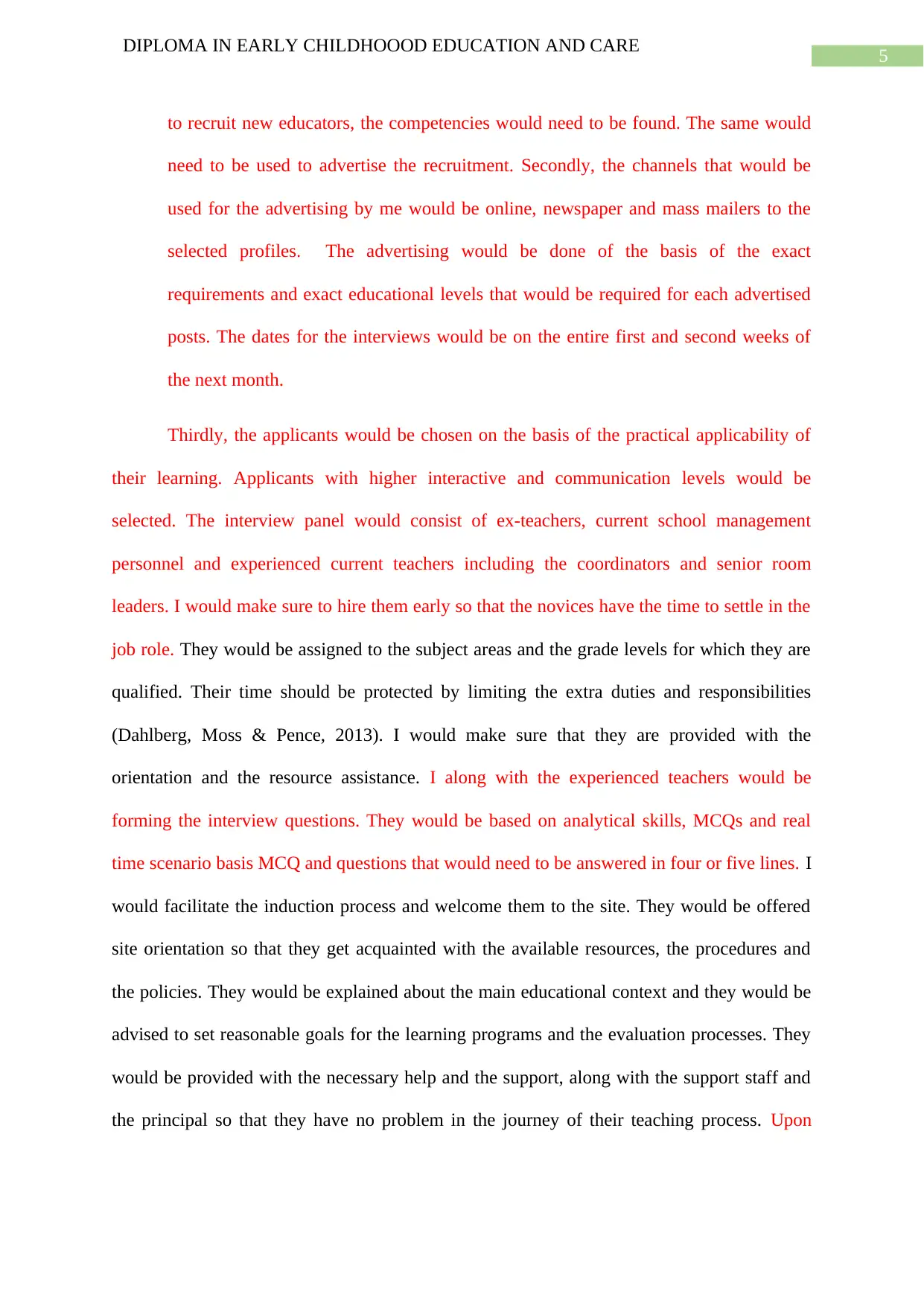
5
DIPLOMA IN EARLY CHILDHOOOD EDUCATION AND CARE
to recruit new educators, the competencies would need to be found. The same would
need to be used to advertise the recruitment. Secondly, the channels that would be
used for the advertising by me would be online, newspaper and mass mailers to the
selected profiles. The advertising would be done of the basis of the exact
requirements and exact educational levels that would be required for each advertised
posts. The dates for the interviews would be on the entire first and second weeks of
the next month.
Thirdly, the applicants would be chosen on the basis of the practical applicability of
their learning. Applicants with higher interactive and communication levels would be
selected. The interview panel would consist of ex-teachers, current school management
personnel and experienced current teachers including the coordinators and senior room
leaders. I would make sure to hire them early so that the novices have the time to settle in the
job role. They would be assigned to the subject areas and the grade levels for which they are
qualified. Their time should be protected by limiting the extra duties and responsibilities
(Dahlberg, Moss & Pence, 2013). I would make sure that they are provided with the
orientation and the resource assistance. I along with the experienced teachers would be
forming the interview questions. They would be based on analytical skills, MCQs and real
time scenario basis MCQ and questions that would need to be answered in four or five lines. I
would facilitate the induction process and welcome them to the site. They would be offered
site orientation so that they get acquainted with the available resources, the procedures and
the policies. They would be explained about the main educational context and they would be
advised to set reasonable goals for the learning programs and the evaluation processes. They
would be provided with the necessary help and the support, along with the support staff and
the principal so that they have no problem in the journey of their teaching process. Upon
DIPLOMA IN EARLY CHILDHOOOD EDUCATION AND CARE
to recruit new educators, the competencies would need to be found. The same would
need to be used to advertise the recruitment. Secondly, the channels that would be
used for the advertising by me would be online, newspaper and mass mailers to the
selected profiles. The advertising would be done of the basis of the exact
requirements and exact educational levels that would be required for each advertised
posts. The dates for the interviews would be on the entire first and second weeks of
the next month.
Thirdly, the applicants would be chosen on the basis of the practical applicability of
their learning. Applicants with higher interactive and communication levels would be
selected. The interview panel would consist of ex-teachers, current school management
personnel and experienced current teachers including the coordinators and senior room
leaders. I would make sure to hire them early so that the novices have the time to settle in the
job role. They would be assigned to the subject areas and the grade levels for which they are
qualified. Their time should be protected by limiting the extra duties and responsibilities
(Dahlberg, Moss & Pence, 2013). I would make sure that they are provided with the
orientation and the resource assistance. I along with the experienced teachers would be
forming the interview questions. They would be based on analytical skills, MCQs and real
time scenario basis MCQ and questions that would need to be answered in four or five lines. I
would facilitate the induction process and welcome them to the site. They would be offered
site orientation so that they get acquainted with the available resources, the procedures and
the policies. They would be explained about the main educational context and they would be
advised to set reasonable goals for the learning programs and the evaluation processes. They
would be provided with the necessary help and the support, along with the support staff and
the principal so that they have no problem in the journey of their teaching process. Upon
⊘ This is a preview!⊘
Do you want full access?
Subscribe today to unlock all pages.

Trusted by 1+ million students worldwide

6
DIPLOMA IN EARLY CHILDHOOOD EDUCATION AND CARE
successful selections of the candidates the selected candidates would be sent emails and at the
same time contacted over phone. They would need to acknowledge the emails.
b) In order to get good points in the appraisal the educator who has been recruited, is
expected to abide by certain general responsibilities, as well as perform the
responsibilities in relation to the education program (Irvine & Farrell, 2013). The
recruiter would be assessed on how effectively she has undertaken the job
responsibilities. The most important parameters are effective interaction, effective
communication, strong and motivated approach to teaching, providing guidance,
creating a strong network for the development of knowledge and effectively co-
ordinating with the fellow educators. The educator also needs to be punctual and
attends to the meetings and the different programs. It is important that effective
supervision and mentoring of the students’ level of competency and places them
accordingly. She on the other hand is expected to meet the standards in the education
practices and the quality areas of the children’s health and safety programs (Goryl,
Neilsen-Hewett & Sweller, 2013).
Part 3: Review of the individual performance and promotion of effective workplace
relations.
a) The performance review of the newly recruited educator in the Wintergrove
Education and Care Service entails that the educator is responsible enough to take
care of the children’s safety. There are significant elements within this that can
maximize work performance levels. The performance review standards would
effectively put forwards all the important competencies that are required by the
educators and the other engaged staffs. The performance review would motivate the
teachers to perform well as they can ensure rewards that are both monitory and
DIPLOMA IN EARLY CHILDHOOOD EDUCATION AND CARE
successful selections of the candidates the selected candidates would be sent emails and at the
same time contacted over phone. They would need to acknowledge the emails.
b) In order to get good points in the appraisal the educator who has been recruited, is
expected to abide by certain general responsibilities, as well as perform the
responsibilities in relation to the education program (Irvine & Farrell, 2013). The
recruiter would be assessed on how effectively she has undertaken the job
responsibilities. The most important parameters are effective interaction, effective
communication, strong and motivated approach to teaching, providing guidance,
creating a strong network for the development of knowledge and effectively co-
ordinating with the fellow educators. The educator also needs to be punctual and
attends to the meetings and the different programs. It is important that effective
supervision and mentoring of the students’ level of competency and places them
accordingly. She on the other hand is expected to meet the standards in the education
practices and the quality areas of the children’s health and safety programs (Goryl,
Neilsen-Hewett & Sweller, 2013).
Part 3: Review of the individual performance and promotion of effective workplace
relations.
a) The performance review of the newly recruited educator in the Wintergrove
Education and Care Service entails that the educator is responsible enough to take
care of the children’s safety. There are significant elements within this that can
maximize work performance levels. The performance review standards would
effectively put forwards all the important competencies that are required by the
educators and the other engaged staffs. The performance review would motivate the
teachers to perform well as they can ensure rewards that are both monitory and
Paraphrase This Document
Need a fresh take? Get an instant paraphrase of this document with our AI Paraphraser
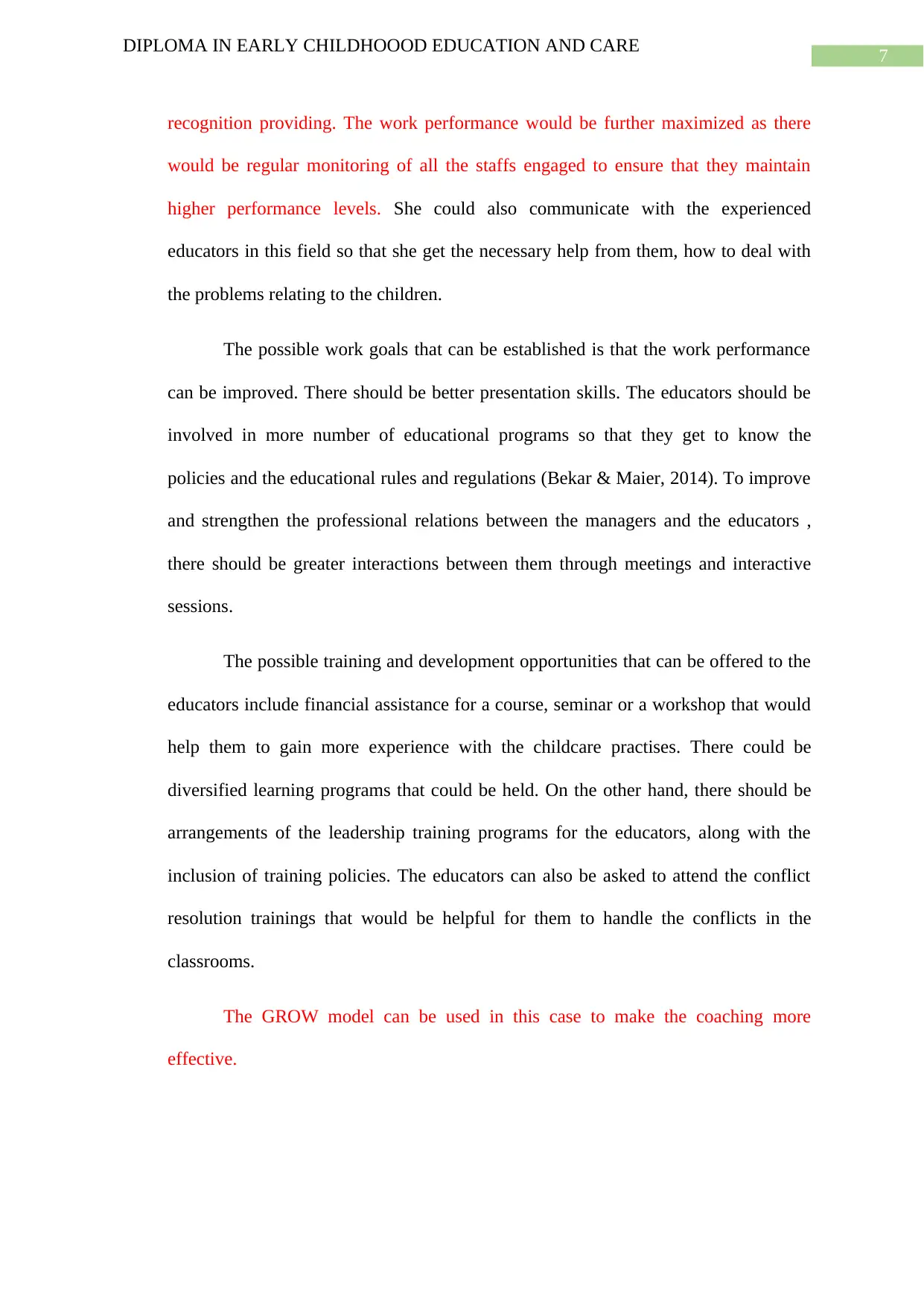
7
DIPLOMA IN EARLY CHILDHOOOD EDUCATION AND CARE
recognition providing. The work performance would be further maximized as there
would be regular monitoring of all the staffs engaged to ensure that they maintain
higher performance levels. She could also communicate with the experienced
educators in this field so that she get the necessary help from them, how to deal with
the problems relating to the children.
The possible work goals that can be established is that the work performance
can be improved. There should be better presentation skills. The educators should be
involved in more number of educational programs so that they get to know the
policies and the educational rules and regulations (Bekar & Maier, 2014). To improve
and strengthen the professional relations between the managers and the educators ,
there should be greater interactions between them through meetings and interactive
sessions.
The possible training and development opportunities that can be offered to the
educators include financial assistance for a course, seminar or a workshop that would
help them to gain more experience with the childcare practises. There could be
diversified learning programs that could be held. On the other hand, there should be
arrangements of the leadership training programs for the educators, along with the
inclusion of training policies. The educators can also be asked to attend the conflict
resolution trainings that would be helpful for them to handle the conflicts in the
classrooms.
The GROW model can be used in this case to make the coaching more
effective.
DIPLOMA IN EARLY CHILDHOOOD EDUCATION AND CARE
recognition providing. The work performance would be further maximized as there
would be regular monitoring of all the staffs engaged to ensure that they maintain
higher performance levels. She could also communicate with the experienced
educators in this field so that she get the necessary help from them, how to deal with
the problems relating to the children.
The possible work goals that can be established is that the work performance
can be improved. There should be better presentation skills. The educators should be
involved in more number of educational programs so that they get to know the
policies and the educational rules and regulations (Bekar & Maier, 2014). To improve
and strengthen the professional relations between the managers and the educators ,
there should be greater interactions between them through meetings and interactive
sessions.
The possible training and development opportunities that can be offered to the
educators include financial assistance for a course, seminar or a workshop that would
help them to gain more experience with the childcare practises. There could be
diversified learning programs that could be held. On the other hand, there should be
arrangements of the leadership training programs for the educators, along with the
inclusion of training policies. The educators can also be asked to attend the conflict
resolution trainings that would be helpful for them to handle the conflicts in the
classrooms.
The GROW model can be used in this case to make the coaching more
effective.
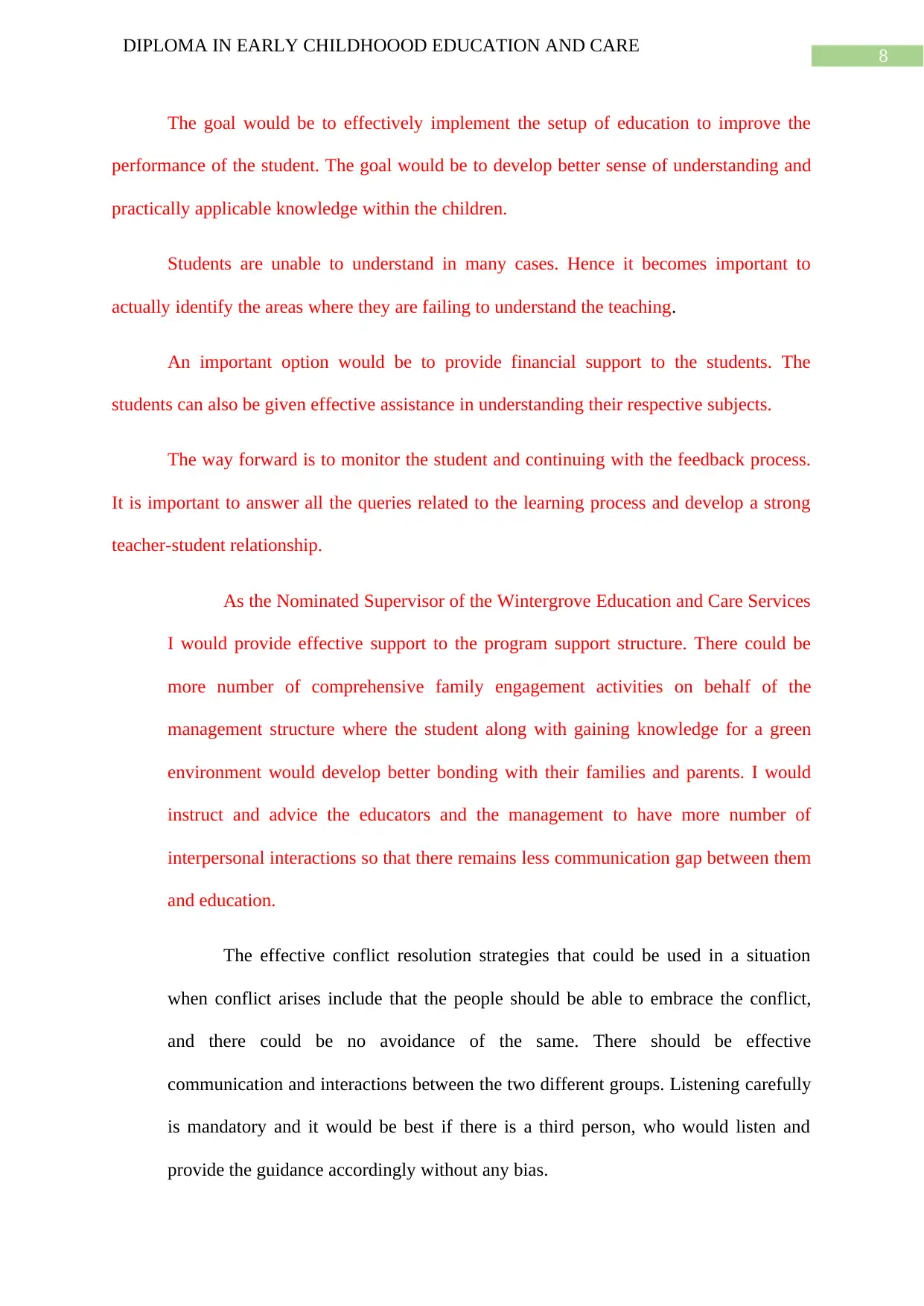
8
DIPLOMA IN EARLY CHILDHOOOD EDUCATION AND CARE
The goal would be to effectively implement the setup of education to improve the
performance of the student. The goal would be to develop better sense of understanding and
practically applicable knowledge within the children.
Students are unable to understand in many cases. Hence it becomes important to
actually identify the areas where they are failing to understand the teaching.
An important option would be to provide financial support to the students. The
students can also be given effective assistance in understanding their respective subjects.
The way forward is to monitor the student and continuing with the feedback process.
It is important to answer all the queries related to the learning process and develop a strong
teacher-student relationship.
As the Nominated Supervisor of the Wintergrove Education and Care Services
I would provide effective support to the program support structure. There could be
more number of comprehensive family engagement activities on behalf of the
management structure where the student along with gaining knowledge for a green
environment would develop better bonding with their families and parents. I would
instruct and advice the educators and the management to have more number of
interpersonal interactions so that there remains less communication gap between them
and education.
The effective conflict resolution strategies that could be used in a situation
when conflict arises include that the people should be able to embrace the conflict,
and there could be no avoidance of the same. There should be effective
communication and interactions between the two different groups. Listening carefully
is mandatory and it would be best if there is a third person, who would listen and
provide the guidance accordingly without any bias.
DIPLOMA IN EARLY CHILDHOOOD EDUCATION AND CARE
The goal would be to effectively implement the setup of education to improve the
performance of the student. The goal would be to develop better sense of understanding and
practically applicable knowledge within the children.
Students are unable to understand in many cases. Hence it becomes important to
actually identify the areas where they are failing to understand the teaching.
An important option would be to provide financial support to the students. The
students can also be given effective assistance in understanding their respective subjects.
The way forward is to monitor the student and continuing with the feedback process.
It is important to answer all the queries related to the learning process and develop a strong
teacher-student relationship.
As the Nominated Supervisor of the Wintergrove Education and Care Services
I would provide effective support to the program support structure. There could be
more number of comprehensive family engagement activities on behalf of the
management structure where the student along with gaining knowledge for a green
environment would develop better bonding with their families and parents. I would
instruct and advice the educators and the management to have more number of
interpersonal interactions so that there remains less communication gap between them
and education.
The effective conflict resolution strategies that could be used in a situation
when conflict arises include that the people should be able to embrace the conflict,
and there could be no avoidance of the same. There should be effective
communication and interactions between the two different groups. Listening carefully
is mandatory and it would be best if there is a third person, who would listen and
provide the guidance accordingly without any bias.
⊘ This is a preview!⊘
Do you want full access?
Subscribe today to unlock all pages.

Trusted by 1+ million students worldwide
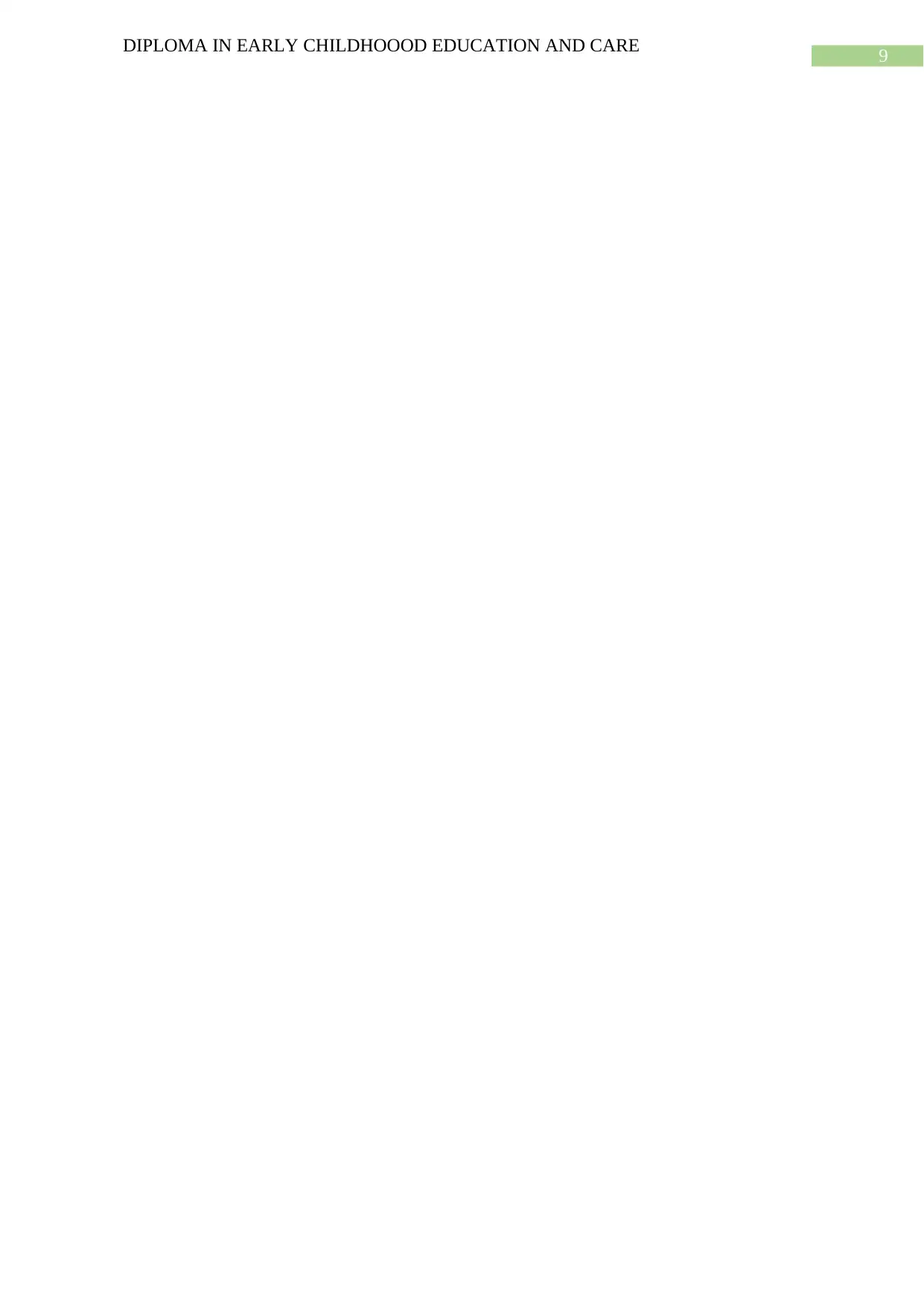
9
DIPLOMA IN EARLY CHILDHOOOD EDUCATION AND CARE
DIPLOMA IN EARLY CHILDHOOOD EDUCATION AND CARE
Paraphrase This Document
Need a fresh take? Get an instant paraphrase of this document with our AI Paraphraser
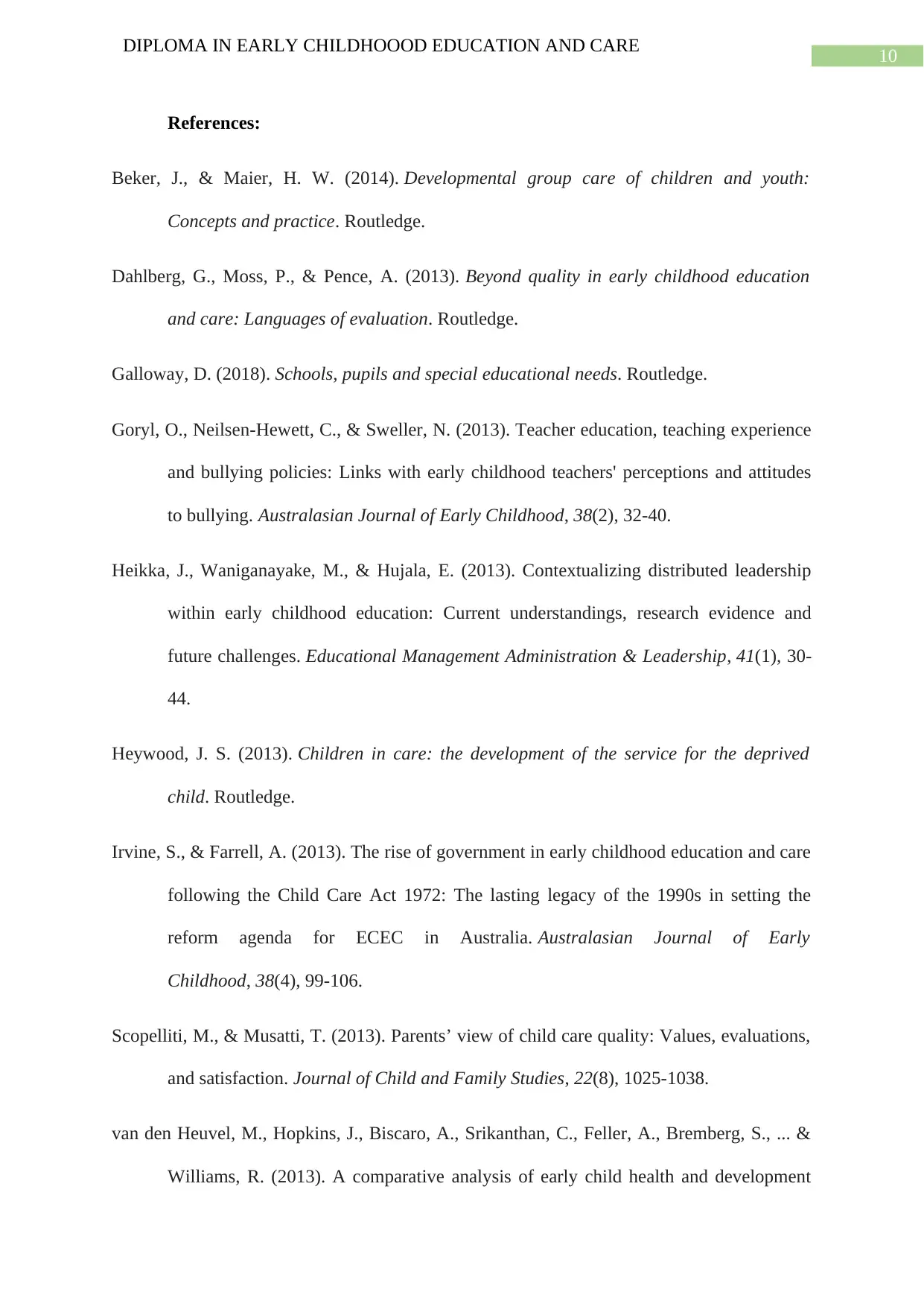
10
DIPLOMA IN EARLY CHILDHOOOD EDUCATION AND CARE
References:
Beker, J., & Maier, H. W. (2014). Developmental group care of children and youth:
Concepts and practice. Routledge.
Dahlberg, G., Moss, P., & Pence, A. (2013). Beyond quality in early childhood education
and care: Languages of evaluation. Routledge.
Galloway, D. (2018). Schools, pupils and special educational needs. Routledge.
Goryl, O., Neilsen-Hewett, C., & Sweller, N. (2013). Teacher education, teaching experience
and bullying policies: Links with early childhood teachers' perceptions and attitudes
to bullying. Australasian Journal of Early Childhood, 38(2), 32-40.
Heikka, J., Waniganayake, M., & Hujala, E. (2013). Contextualizing distributed leadership
within early childhood education: Current understandings, research evidence and
future challenges. Educational Management Administration & Leadership, 41(1), 30-
44.
Heywood, J. S. (2013). Children in care: the development of the service for the deprived
child. Routledge.
Irvine, S., & Farrell, A. (2013). The rise of government in early childhood education and care
following the Child Care Act 1972: The lasting legacy of the 1990s in setting the
reform agenda for ECEC in Australia. Australasian Journal of Early
Childhood, 38(4), 99-106.
Scopelliti, M., & Musatti, T. (2013). Parents’ view of child care quality: Values, evaluations,
and satisfaction. Journal of Child and Family Studies, 22(8), 1025-1038.
van den Heuvel, M., Hopkins, J., Biscaro, A., Srikanthan, C., Feller, A., Bremberg, S., ... &
Williams, R. (2013). A comparative analysis of early child health and development
DIPLOMA IN EARLY CHILDHOOOD EDUCATION AND CARE
References:
Beker, J., & Maier, H. W. (2014). Developmental group care of children and youth:
Concepts and practice. Routledge.
Dahlberg, G., Moss, P., & Pence, A. (2013). Beyond quality in early childhood education
and care: Languages of evaluation. Routledge.
Galloway, D. (2018). Schools, pupils and special educational needs. Routledge.
Goryl, O., Neilsen-Hewett, C., & Sweller, N. (2013). Teacher education, teaching experience
and bullying policies: Links with early childhood teachers' perceptions and attitudes
to bullying. Australasian Journal of Early Childhood, 38(2), 32-40.
Heikka, J., Waniganayake, M., & Hujala, E. (2013). Contextualizing distributed leadership
within early childhood education: Current understandings, research evidence and
future challenges. Educational Management Administration & Leadership, 41(1), 30-
44.
Heywood, J. S. (2013). Children in care: the development of the service for the deprived
child. Routledge.
Irvine, S., & Farrell, A. (2013). The rise of government in early childhood education and care
following the Child Care Act 1972: The lasting legacy of the 1990s in setting the
reform agenda for ECEC in Australia. Australasian Journal of Early
Childhood, 38(4), 99-106.
Scopelliti, M., & Musatti, T. (2013). Parents’ view of child care quality: Values, evaluations,
and satisfaction. Journal of Child and Family Studies, 22(8), 1025-1038.
van den Heuvel, M., Hopkins, J., Biscaro, A., Srikanthan, C., Feller, A., Bremberg, S., ... &
Williams, R. (2013). A comparative analysis of early child health and development
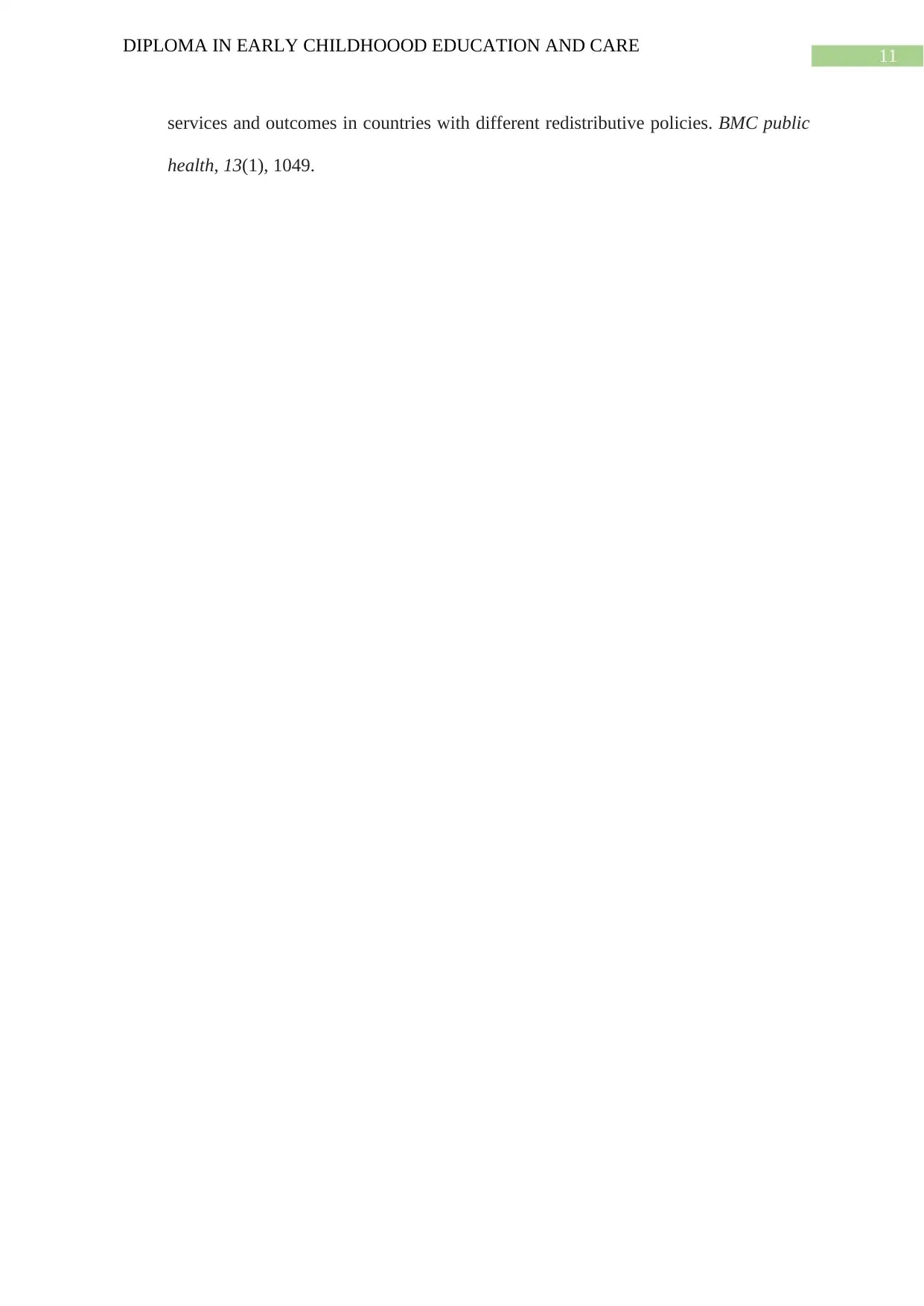
11
DIPLOMA IN EARLY CHILDHOOOD EDUCATION AND CARE
services and outcomes in countries with different redistributive policies. BMC public
health, 13(1), 1049.
DIPLOMA IN EARLY CHILDHOOOD EDUCATION AND CARE
services and outcomes in countries with different redistributive policies. BMC public
health, 13(1), 1049.
⊘ This is a preview!⊘
Do you want full access?
Subscribe today to unlock all pages.

Trusted by 1+ million students worldwide
1 out of 12
Related Documents
Your All-in-One AI-Powered Toolkit for Academic Success.
+13062052269
info@desklib.com
Available 24*7 on WhatsApp / Email
![[object Object]](/_next/static/media/star-bottom.7253800d.svg)
Unlock your academic potential
Copyright © 2020–2025 A2Z Services. All Rights Reserved. Developed and managed by ZUCOL.




